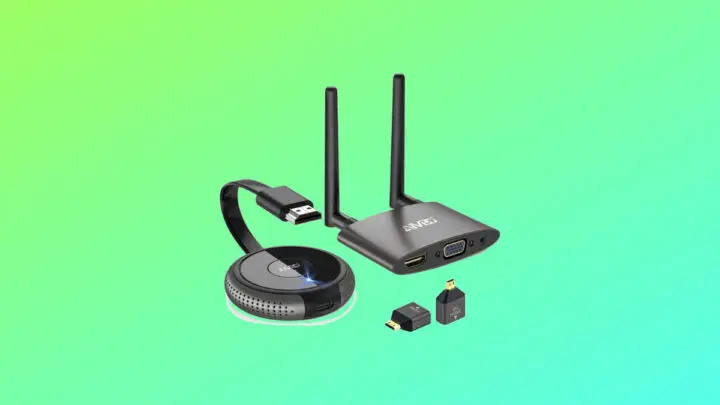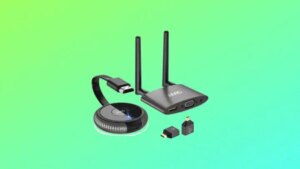HDMI stands for High-Definition Multimedia Interface. It is a standard for transferring digital video and audio from a source, such as a computer or TV cable box, to a computer monitor, TV, or projector simultaneously. It was created by a consortium of electronics manufacturers and has since become widely used, with almost all televisions & computer monitors supporting the interface. Wireless HDMI lets you stream video and audio from any HDMI output device, such as a game console, computer, or cable box.
It does allow you to remove unsightly HDMI cables from the setup and even store the video source in a separate room. It’s also a straightforward technique to use, but there are some things you need to understand before buying, as well as some limitations regarding capabilities and wireless interference. Wireless HDMI, like many other modern technologies, harnesses the power of invisible electromagnetic radiation to perform a form of magic: beaming audio and video signals across a room in the same way that cellphone towers girder content to the smartphone in your pocket.
What will you see here?
Wireless HDMI

Unlike screen mirroring apps like Apple AirPlay, wireless HDMI doesn’t require an internet connection. IR transmitters are already present in most HDMI gadgets. These transmitters let you operate distant items with TV remote controls. For many wireless HDMIs configurations, these IR transmitters are required. After all, switching TV channels would require moving from room to room. And finding an HDMI transmitter nearby a source device, like a TV or streaming box. And then connecting it to a port are the only two steps required to set up the connection.
Even in the office, wireless HDMI has applications. It enables several monitors and interfaces to receive data from a single source. By making it perfect for video conference rooms and information consoles. It’s as simple as plugging in a cable, with none of the hassles in between. However, power cables are required for the receiver and transmitter units. More recent models can draw additional power from the devices they plug into.
Advantages
The main advantages of wireless HDMI are convenience and the absence of obstructions, which are discussed below:-
- Your TV has run out of HDMI ports.
Most televisions have at least 2 HDMI ports, but this isn’t always sufficient. The good news is that many wireless HDMI receivers have multiple input ports, allowing you to connect additional sources easily. Others could even stream to multiple TVs at the same time.
- When your origin is located elsewhere
You can attach a projector in one’s office boardroom or stream Netflix from a console in your bedroom to a TV in the living room. There is no need for the devices to be placed next to each other, nor is it necessary to run long lengths of cable to attach them.
- Switch to wireless
People can all agree that we’d like to get rid of some of the wires in our homes, particularly around the backs of our televisions. This is made possible by wireless HDMI. It’s even more important if you have a wall-mounted television.
Disadvantages
Unfortunately, This has some disadvantages, with cost being just one of them. Despite these drawbacks, wireless HDMI can still be a terrific option for becoming completely wire-free in your home. It also offers a lot of adaptability and accessibility for other devices and family members when streaming your preferred movies, music, and games. There is also the need to add additional hardware to your home setup in the shape of wireless HDMI transmitters and receivers, which can also have the unintended consequence of increasing rather than reducing your AV clutter.
There are several potential drawbacks to using wireless HDMI:
- Latency:
Because wireless HDMI technology relies on a wireless connection, some latency or delay in video and audio transmission may occur. This is especially noticeable in high-resolution or fast-paced streaming videos, such as playing games or action movies. Wireless HDMI devices typically have a range of around 30 feet. You may need to be close to the transmitter to establish a stable connection.
- Interference:
Other electrical equipment or interference in the environment, such as walls, metal objects, or even other wireless connections, can disrupt wireless HDMI signals. As a result, the signal may drop out or degrade in reliability.
- Compatibility:
Because wireless HDMI technology is incompatible with all HDMI devices, you may need to purchase additional equipment or adapters.
- Cost:
Wireless HDMI technology can be more expensive than traditional HDMI cables, particularly if additional equipment or adapters are required to make it work with your devices.
Expected Price Range
The finest HDMI cables offer a far less costly method of obtaining the same task as wireless HDMI transmitters and receivers, which can range in price from $130 for a device like the RXZ Wireless HDMI Transmitter and Receiver to $300 for the J-Tech Digital Wireless HDMI 4K Extender.
Provided Range

Based on the manufacturer or type, an HDMI transmitter’s ranges can fluctuate. But they establish communication at approximately 30 feet and can go as high as 3000 feet. The position of an HDMI transmitter should consider any walls, furniture, or appliances that might block the signal.
The range of a wireless HDMI connection varies depending on the device and technology used. However, you can generally expect a range of 30 feet or less. To maintain a stable connection, the wireless transmitter and receiver should be relatively close to each other.
It’s important to note that various factors, including wireless signal strength, obstacles or interference, and the reliability of the wireless HDMI technology, can influence the range.
You may extend the range of a wireless HDMI connection by using a wireless HDMI extender or repeater, which can amplify the signal and allow it to travel further distances.
Wireless HDMI is a specialized product.

The possibility for general adoption or practical application of Wireless HDMI is limited, even though some people may find it incredibly beneficial. Wireless HDMI has a lot of issues, so unless you’re attempting to organize your entertainment centre or send a cable signal down into your basement, there’s not much of a reason to use it.
Most wireless HDMI systems cost around $200 and come with a single transmitter and receiver. To assemble a respectable army of its items, you’d need to spend more than $1,000, and since they don’t support 4K, you could have to compromise on video quality.
Wireless HDMI is an Alternative to HDMI Cables
Over a decade ago, HDMI cables became the industry standard for transporting high-definition video. But there are several clear disadvantages to HDMI cables. A few stray HDMI wires can make your entertainment centre look like a rat’s nest. And confine your cable box and gaming consoles to one space. Many solutions are available and are all rather simple to set up. All you need to do is hook a transmitter to an HDMI port on a video source. And a receiver to an HDMI port on a TV.
Know more about HDMI Cables

An HDMI cable comprises four protected twisted pairs with impedances of 100 (15%) and seven separate conductors. HDMI cables with Ethernet differ in that three of the separate conductors form an additional shielded twisted pair instead of three separate conductors. There are several HDMI cable types to choose from and a special cable certification designation; each is designed to meet a specific performance standard.
Although some brands include gold-plated HDMI connectors, HDMI connectors are frequently silver. The colour or content of the connector will not affect performance. A flexible type of plastic usually protects the core wiring in the cable. Some brands, however, use braided polyester cables, which can be easier to instal in tight spaces – or look better to you.
Dynamic frequency selection is the technology at the core of wireless HDMI transmitters. A wireless HDMI transmitter employs low-band radio frequencies to do away with the requirement for connection. It keeps track of the radio frequency spectrum to find and pick the ideal channel for signal transmission. With a latency of about 1 ms, the signal that DFS generates from a wireless HDMI transmitter is stable enough to stream high-quality audio and HD video material.
Are HDMI wireless connections worth it?
Thanks to this technology, any media device can wirelessly transmit content to your TV in resolutions as high as 4K. This covers various devices, including game consoles and cable set-top boxes. There is no lag or quality loss; all that is lost are the tangled cords and clutter.
Has wireless HDMI experienced lag?
As a result, there seems to be some lag in most Wireless HDMI systems. In most cases, the best way to determine a product’s latency is to look at its range of goods. Products with a few milliseconds of delay typically include the 660-foot-range J-Tech Digital HDbitT.
Conclusion
Wireless HDMI can assist in solving some problems very well, such as irregular hardware placement and trying to keep things tidy. Still, there are some creature comforts that a streaming stick provides that wireless HDMI does not.
Not to mention that streaming sticks frequently come with their own remote controls and another back end, making them more of an all-in-one solution. Another excellent option to organize your entertainment centre is wireless HDMI. If you don’t want to spend $1,000 on items, you could always use a transmitter and an HDMI switch to quickly and efficiently get rid of most HDMI cords from your entertainment centre. Additionally, since there are no cables to dangle from your ceiling, it can make home projectors much more convenient.
















